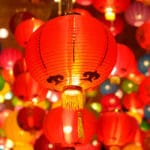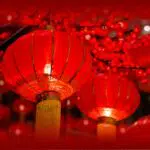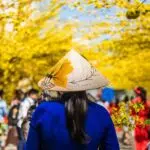If you feel the ground trembling beneath your feet on January 22 — don’t fear! It’s simply the beginning of the Chinese New Year. You’ll find a full 20% of the Earth’s population celebrating — using more fireworks than any other day of the year. It’s a celebration marked by good food, red envelopes, and blessings for everyone.
When is Chinese New Year 2025?
Chinese New Year, or Lunar New Year, is a 15-day festival that is celebrated annually depending on the sighting of the new moon. The occasion is also known as the Spring Festival, and an animal is associated with each New Year. The animals rotate and repeat according to a fixed cycle.
History of Chinese New Year
Chinese New Year is the Chinese festival that celebrates the beginning of a new year on the traditional Chinese calendar. The festival is usually referred to as the Spring Festival in mainland China and is one of several Lunar New Years in Asia. The first day of Chinese New Year begins on the new moon that appears between January 21 and February 20. It’s a major holiday in Greater China and has strongly influenced lunar new year celebrations of China’s neighboring cultures, including the Korean New Year, the Tết of Vietnam, and the Losar of Tibet. It is also celebrated worldwide in regions and countries with significant Chinese populations, like Singapore, Indonesia, Malaysia, North America, and Europe.In 1928, the Kuomintang party decreed that Chinese New Year will fall on the first of January, following the Gregorian Calendar, but this was abandoned due to overwhelming opposition from the populace. In 1967 during the Cultural Revolution, official Chinese New Year celebrations were banned in China. The State Council of the People’s Republic of China announced that the public should change customs, have a revolutionized and fighting Spring Festival, and since people needed to work on Chinese New Year Eve, they did not have holidays during Spring Festival day. The public celebrations were reinstated by the time of the Chinese economic reform.The festival was traditionally a time to honor deities as well as ancestors. Within China, regional customs and traditions concerning the celebration of the New Year vary widely, and the evening preceding Chinese New Year’s Day is frequently regarded as an occasion for Chinese families to gather for the annual reunion dinner. It is also traditional for every family to thoroughly clean their house, in order to sweep away any ill fortune and to make way for incoming good luck.
Chinese New Year timeline
Though it's not completely clear when exactly Chinese New Year celebrations began, it is said to have originated from the year-end religious ceremony observed during the Shang Dynasty.
Wanting China to celebrate New Year the same day as other cultures, the Kuomintang Party attempted to move Chinese New Year to January 1.
Chinese New Year celebrations were banned in an attempt to westernize Chinese culture.
This Chinese New Year will welcome the Year of the Ox.
Chinese New Year Traditions
The Chinese Zodiac consists of 12 animals. These are Rat, Ox, Tiger, Rabbit, Dragon, Snake, Horse, Goat, Monkey, Rooster, Dog, and Pig. In that order. The Chinese New Year is a grand one, just like the New Year celebration of the Gregorian calendar. A tradition closely followed on this day is getting together with the family to have a feast. Certain foods are symbolic and are commonplace during the Chinese New Year. Dumplings represent wealth, so they are eaten in abundance, with fish being another food that is eaten a lot. Red is generally considered a lucky color in China and during the Chinese New Year, it is seen everywhere – representing vitality, beauty, luck, happiness, and good fortune.
Chinese New Year FAQs
How is Chinese New Year celebrated?
The Spring Festival, Chinese New Year, is celebrated with lots of food, the color red, and honoring ancestors.
Why is the Chinese New Year different?
Chinese New Year is a lunar holiday, meaning it’s celebrated at the start of a new moon rather than the beginning of the Gregorian calendar.
What was the animal for Chinese New Year 2019?
The 2019 Chinese New Year welcomed the Year of the Earth Pig on February 5.
Chinese New Year Activities
-
Remember your ancestors
Amid all the celebrations, it's easy to forget that Chinese New Year is really a holiday for the whole family — children and elders alike. Take a moment to appreciate those you love most.
-
Eat and be merry
First, consider all the dim sum delights that await for Chinese New Year. Then, remember to enjoy the fireworks, parades, and general merriment. Chinese New Year focuses on creating good luck for the year to come. Take time to enjoy yourself and others around you.
-
Share the traditional red envelopes
The red symbolizes good luck. The monetary gifts are meant to bring the recipient good fortune. Just make sure to gift cash in even numbers and do not have the number four in the amount.
5 Facts You Didn’t Know About Chinese New Year
-
1/4 of the world's population celebrates it.
More than 2 billion people celebrate or acknowledge the Chinese New Year.
-
The Chinese New Year Festival lasts till the Lantern Festival
Typically lasting 16 days, each day of the Chinese New Year has a special activity that is celebrated.
-
Appeasing the Harvest Gods
In earlier times, the Chinese New Year was a time for praying to the harvest gods for a fruitful year ahead.
-
Lucky red envelopes
Red envelopes are given as a way of wishing good luck.
-
The largest annual migration happens during this festival.
The reunion dinner with the family is the most important aspect of the Chinese Spring Festival and people travel long distances to be home for the occasion.
Why We Love Chinese New Year
-
It's red for a reason
Red is an auspicious color for the Chinese New Year, denoting prosperity and energy — which ward off evil spirits and negativity. Red lanterns, envelopes, and firecrackers make everything festive during the winter months.
-
New Year's (Eve) feasting
What is a celebration without feasting with friends and family? Chinese New Year's Eve dinner is one of the most important occasions of the year — celebrated with long noodles, trays of food (naturally), and sweet, plump oranges to spread the wealth.
-
No chores
Good luck is at its peak in the New Year. You don't want to sweep it away, do you? Take a breather from vacuuming and mopping, and go get your dumpling on! (If you must clean, make sure it's taken care of beforehand.)
Chinese New Year dates
| Year | Date | Day |
|---|---|---|
| 2021 | February 12 | Friday |
| 2022 | February 1 | Tuesday |
| 2023 | January 22 | Sunday |
| 2024 | February 10 | Saturday |
| 2025 | January 29 | Wednesday |




















